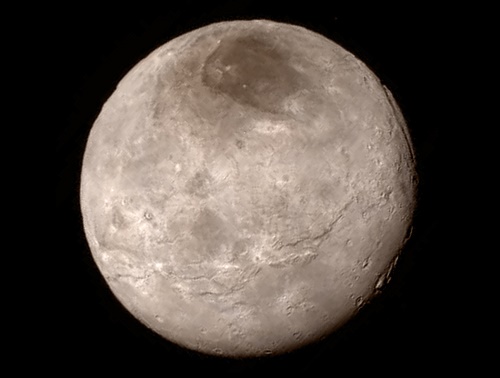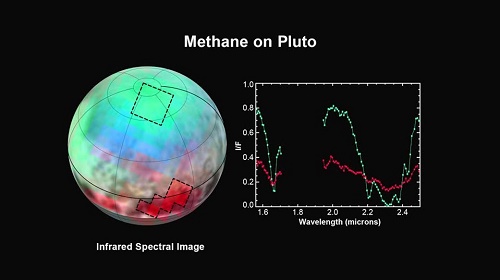I’m on the road and don’t have a lot of time for writing, but I want to go ahead and get these new Pluto images up. They’re now available on the NASA site, and were introduced at the news conference at JHU/APL that just concluded. I’ll also quote just a bit of the news release for each photo.

New close-up images of a region near Pluto’s equator reveal a giant surprise: a range of youthful mountains rising as high as 11,000 feet (3,500 meters) above the surface of the icy body.
The mountains likely formed no more than 100 million years ago — mere youngsters relative to the 4.56-billion-year age of the solar system — and may still be in the process of building, says Jeff Moore of New Horizons’ Geology, Geophysics and Imaging Team (GGI). That suggests the close-up region, which covers less than one percent of Pluto’s surface, may still be geologically active today.
This one I mis-typed in my Twitter coverage for those who were following it, but the correct number is 100 million years. Young mountains, and check that altitude! The lack of cratering implies a young surface, but we can rule out tidal effects as a driver for geology here. “This may cause us to rethink what powers geological activity on many other icy worlds,” says GGI deputy team leader John Spencer of the Southwest Research Institute in Boulder, Colo.

Remarkable new details of Pluto’s largest moon Charon are revealed in this image from New Horizons’ Long Range Reconnaissance Imager (LORRI), taken late on July 13, 2015 from a distance of 289,000 miles (466,000 kilometers).
A swath of cliffs and troughs stretches about 600 miles (1,000 kilometers) from left to right, suggesting widespread fracturing of Charon’s crust, likely a result of internal processes. At upper right, along the moon’s curving edge, is a canyon estimated to be 4 to 6 miles (7 to 9 kilometers) deep.
Again, a relatively young surface shaped by geological activity. And note the diffuse boundary at the dark region at the north pole, suggesting we’re looking at a thin film of material. “Underlying it is a distinct, sharply bounded, angular feature; higher resolution images still to come are expected to shed more light on this enigmatic region.”

The latest spectra from New Horizons Ralph instrument reveal an abundance of methane ice, but with striking differences from place to place across the frozen surface of Pluto.
“We just learned that in the north polar cap, methane ice is diluted in a thick, transparent slab of nitrogen ice resulting in strong absorption of infrared light,” said New Horizons co-investigator Will Grundy, Lowell Observatory, Flagstaff, Arizona. In one of the visually dark equatorial patches, the methane ice has shallower infrared absorptions indicative of a very different texture. “The spectrum appears as if the ice is less diluted in nitrogen,” Grundy speculated “or that it has a different texture in that area.”
We have so much data to come in the next sixteen months, and given the surprises we’ve already been dealt, it’s clear we’ll be talking about Pluto/Charon for some time. As one of the participants in the press briefing yesterday said, we’re not just re-writing the books now. We’re going to be writing entirely new books.



These images are just fantastic, and the data just as interesting. From mere crude imaging a decade ago by Hubble, we now have superb detailed images of Pluto and Charon. This makes Pluto a much more “real” world. As the imaging and data rolls out, Pluto will be transformed. Who will write stories set on this newly updated world?
3.5 km mountains are a giant surprise? Earth’s Chimborazo is 6.4 km, Mars Olympus Mons 25 km. Seeing that Pluto has a shallower gravity well, wouldn’t even higher mountains be expected?
They’re mountains of water ice, so it’s probably not as easy for them to get that tall.
Hop David: “3.5 km mountains are a giant surprise?”
Well, yes. Pluto was expected to have little to no tectonic activity. But those canyons on Charon seem even more interesting.
Commentary from The Planetary Society:
http://www.planetary.org/blogs/emily-lakdawalla/2015/07151720-first-look-at-new-horizons-pluto-charon.html
NPR article on how New Horizons’ exploration of Pluto is our legacy to the future:
http://www.npr.org/sections/13.7/2015/07/15/423223189/pluto-s-encounter-is-a-legacy-from-our-generation
Expressing the wonder of the newly revealed Pluto system through art:
http://takingnote.blogs.nytimes.com/2015/07/16/understanding-pluto-through-paint/?smid=fb-share&_r=0
Pluto as seen from June 4, 1960:
http://galacticjourney.org/?p=472
NOVA aired an up to date special on the NH probe last night that is available in full on the PBS site.
http://www.pbs.org/wgbh/nova/
@Christopher L. Bennett
‘They’re mountains of water ice, so it’s probably not as easy for them to get that tall.’
At the temperature of Pluto ice would have the strength of solid rock allowing much higher mountains than observed.
I was expecting a subdued surface due to the nitrogen ice greenhouse effect, the nitrogen ice is relatively clear when formed, it allows light in but when it hits something dark it will heat that area strongly enough to rupture the ice layer above it through pressure build up. These effects are seen on Triton a moon around Neptune.
The pictures were well worth the wait
Everybody repeat “mountains of ice , mountains of ice . . . ” but where are the proofs ? Why not , silicates mountains ?
Any idea what that causes the mountains – plate tectonics/cryovulcanism/other? What is the energy source to drive these processes, because they must still be extant if these features are so young?
I recently read that huge impacts on Earth could cause teh massive lava flows that were associated with some extinction events, e.g. Permian. Is this a possible energy source for Pluto and similar worlds to create mountains? Do we need other energy sources to keep the bulk of the planet liquid enough to allow these geologic features to form?
@ Alex,
The initial speculation by a NH scientist reviewing the image was that the mountains may be the result of a “slowly freezing” core of water under the surface of Pluto. The mountains “might” be the result of the heat exchange between the hot and cold layers creating the force necessary to cause an uplift.
On a personal note, I was hoping for proof of an active ring system to substantiate the Pluto/Charon collision theory being the event that created the other moons orbiting Pluto.
I was also wondering if there were very large crater along right the edge of the Charin photo or was that a digital artifact or distortion created by an attempt to round out the image edge?
A stunning albeit fake 3d render of the Pluto close-up
http://youtu.be/37TNyDHZExA
And plenty of musings at
http://www.unmannedspaceflight.com/index.php?showtopic=7986
@galacsi
Beyond the frost/ice line water accumulates more than rock because there was more of it during the solar systems formation than silicate rock.